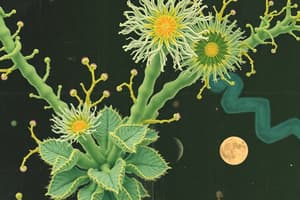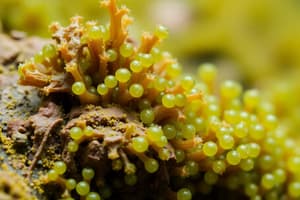Podcast
Questions and Answers
What do algae contribute to the environment?
What do algae contribute to the environment?
They are major producers of oxygen.
Describe the characteristic of phytoplankton.
Describe the characteristic of phytoplankton.
They are free-floating, photosynthetic organisms found in marine environments.
Describe the characteristic of algae.
Describe the characteristic of algae.
They often grow in areas where other forms of life may not.
Describe the macroscopic algae special structure.
Describe the macroscopic algae special structure.
What is agar made from?
What is agar made from?
What type of algae are used as filters?
What type of algae are used as filters?
What genus causes neurotoxins that are toxic to humans after eating shellfish?
What genus causes neurotoxins that are toxic to humans after eating shellfish?
Which organisms may cause red tide?
Which organisms may cause red tide?
Which dinoflagellate kills fish by dispersing toxins directly into the water?
Which dinoflagellate kills fish by dispersing toxins directly into the water?
Which single-celled eukaryotic organisms lack chlorophyll?
Which single-celled eukaryotic organisms lack chlorophyll?
Protozoans classification is based on?
Protozoans classification is based on?
Sarcodina move by use of?
Sarcodina move by use of?
Describe the importance of the food chain as it relates to protozoans.
Describe the importance of the food chain as it relates to protozoans.
What is the difference between a trophozoite and a cyst?
What is the difference between a trophozoite and a cyst?
What is schizogony?
What is schizogony?
Describe the characteristics of fungi.
Describe the characteristics of fungi.
Which organisms return carbon dioxide to the atmosphere and nitrogen to the soil?
Which organisms return carbon dioxide to the atmosphere and nitrogen to the soil?
Describe the sexual reproduction of Deuteromycetes.
Describe the sexual reproduction of Deuteromycetes.
The terms yeast, mold, and mushroom refer to fungal...?
The terms yeast, mold, and mushroom refer to fungal...?
Define mycelium.
Define mycelium.
What is a dimorphic fungi?
What is a dimorphic fungi?
What causes asthma?
What causes asthma?
The pH at which most fungi prefer (or thrive at) is?
The pH at which most fungi prefer (or thrive at) is?
List the habitat requirement of protozoa.
List the habitat requirement of protozoa.
What are aflatoxins?
What are aflatoxins?
Coccidiomycosis is what type of disease and is caused by which organism?
Coccidiomycosis is what type of disease and is caused by which organism?
What are lichens?
What are lichens?
Lyme disease is transmitted by?
Lyme disease is transmitted by?
Pediculus humanus causes what disease?
Pediculus humanus causes what disease?
How do lice and mice transmit disease?
How do lice and mice transmit disease?
What is a nematode?
What is a nematode?
Describe tapeworms.
Describe tapeworms.
What are not arthropods?
What are not arthropods?
Sarcoptes scabiei transmit what disease and how?
Sarcoptes scabiei transmit what disease and how?
How do fleas cause disease?
How do fleas cause disease?
Describe Gonyaulax species.
Describe Gonyaulax species.
Algae may directly infect humans and cause disease.
Algae may directly infect humans and cause disease.
Algae have a vascular system very similar to that found in plants.
Algae have a vascular system very similar to that found in plants.
Flashcards are hidden until you start studying
Study Notes
Algae and Their Contributions
- Algae are essential producers of oxygen in aquatic environments.
- Phytoplankton are free-floating, photosynthetic organisms vital for marine ecosystems.
- Algae often inhabit harsh environments where other life forms struggle to survive.
- Macroscopic algae feature a structure known as holdfast, which anchors them to substrates.
- Agar, used in various applications, is derived from algae.
Types and Effects of Algae
- Diatoms possess silicon dioxide shells, making them valuable as economic filters.
- Gonyaulax spp. produce neurotoxins harmful to humans when shellfish are consumed.
- The dinoflagellate Gymnodinium is known to contribute to harmful red tides.
- Pfiesteria, another dinoflagellate, releases toxins that can kill fish directly in water.
Protozoa Characteristics
- Protozoa are single-celled eukaryotic organisms that lack chlorophyll.
- Classification of protozoans is based on their locomotion methods.
- Sarcodina move using pseudopodia (false feet).
- Protozoans play a key role in the food chain by consuming large amounts of bacteria and algae.
- Many protozoa can exist as a trophozoite (active form) or as a cyst (dormant form).
Reproduction and Life Cycle of Protozoa
- Schizogony is a form of asexual reproduction involving multiple fissions common in protozoa.
Characteristics of Fungi
- Fungi can be aerobic or facultatively anaerobic, adapting to various environments.
- Fungi and bacteria recycle carbon dioxide and nitrogen back into the ecosystem.
- Sexual reproduction in Deuteromycetes has not been directly observed; they are categorized using rRNA analysis.
Fungal Structures and Diseases
- Terms like yeast, mold, and mushroom describe the morphology of fungi.
- Mycelium refers to a network of fungal filaments called hyphae.
- Dimorphic fungi can exist as both mycelia and yeast, often linked to human diseases.
- Fungal spores are potential allergens and can cause respiratory conditions such as asthma.
Habitat and Toxic Substances
- Protozoa require moist environments to thrive.
- Aflatoxins, produced by Aspergillus species, are potent carcinogens found in contaminated foods like peanuts.
- Coccidioidomycosis is a fungal infection caused by Coccidioides species.
Lichens and Disease Transmission
- Lichens are symbiotic associations between fungi and algae.
- Lyme disease is spread by ticks, while Pediculus humanus (lice) only infests humans and can transmit bacterial infections.
- Diseases caused by lice and mice are transmissible through personal contact.
Nematodes and Tapeworms
- Nematodes are roundworms found in the gastrointestinal tract or bloodstream.
- Tapeworms, lacking a digestive system, can be contracted through the consumption of undercooked meat.
Arthropods and Other Pathogens
- Flukes are not classified as arthropods.
- Sarcoptes scabiei causes scabies through skin contact.
- Fleas can transmit diseases such as tapeworms to children if ingested and can carry Yersinia pestis, the causative agent of the plague.
Miscellaneous Algal Facts
- Gonyaulax species produce a non-protein neurotoxin and belong to a group known as dinoflagellates.
- Algae do not directly infect humans or cause diseases.
- Algae lack a vascular system comparable to that of higher plants.
Studying That Suits You
Use AI to generate personalized quizzes and flashcards to suit your learning preferences.





